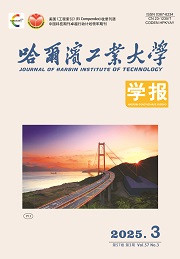| 引用本文: | 朱楠,诸葛爱军,喻志发,朱耀庭,李雨润.湿地湖泊相黏土胶结结构性与各向异性本构模型[J].哈尔滨工业大学学报,2025,57(3):160.DOI:10.11918/202312049 |
| ZHU Nan,ZHUGE Aijun,YU Zhifa,ZHU Yaoting,LI Yurun.A structured and anisotropic constitutive model considering bonding for marshy-lacustrine clay[J].Journal of Harbin Institute of Technology,2025,57(3):160.DOI:10.11918/202312049 |
|
| |
|
|
| 本文已被:浏览 41次 下载 59次 |

码上扫一扫! |
|
|
| 湿地湖泊相黏土胶结结构性与各向异性本构模型 |
|
朱楠1,2,3,4,5,诸葛爱军1,2,3,4,5,喻志发1,2,3,4,5,朱耀庭1,2,3,4,5,李雨润6,7
|
|
(1.中交天津港湾工程研究院有限公司,天津 300222;2.港口岩土工程技术交通行业重点实验室,天津 300222; 3.天津市港口岩土工程技术重点实验室,天津 300222;4.中交集团岩土工程重点实验室,天津 300222; 5.中交第一航务工程局有限公司,天津 300461;6.河北工业大学 土木与交通学院,天津 300401; 7.河北省土木工程技术研究中心,天津 300401)
|
|
| 摘要: |
| 湿地湖泊相黏土由湖泊湿地或古湖泊湿地干缩形成,具有明显的胶结特性、结构性及初始各向异性。为了有效描述湿地湖泊相黏土的应力应变关系及屈服特性,建立了考虑胶结强度演化、结构性及初始各向异性影响的土体弹塑性本构模型。基于纯剪切应力路径下胶结强度p′r的变化规律,以及等向压缩条件下屈服面与胶结强度p′r的对应关系,提出了适用于等向压缩、纯剪切及压缩剪切共同作用3种应力状态的胶结强度演化规律;基于修正剑桥模型理论框架,引入了胶结强度演化规律,并考虑体积应变硬化和剪切应变硬化的影响对硬化规律进行改进;引入各向异性参数ηNCL,对p′-q平面进行极坐标变换来反映初始各向异性的影响;采用相关联流动法则,建立了土体的胶结结构性和各向异性本构模型。所有的模型参数均可通过固结压缩试验、三轴试验及K0固结试验获得。模型预测与试验对比结果表明:所提出的模型能够合理地描述胶结强度及结构性与初始各向异性对土体应力应变特性及屈服特性的影响,可以有效反映加载过程中土体胶结强度的渐进退化,以及在卸载应力路径下胶结强度对土体抗拉强度的提高作用。该模型考虑了胶结强度特性、结构性和各向异性的影响,可以更好地表征湿地湖泊相黏土的力学响应。 |
| 关键词: 胶结强度 结构性 初始各向异性 硬化规律 本构模型 湿地湖泊相黏土 |
| DOI:10.11918/202312049 |
| 分类号:TU43 |
| 文献标识码:A |
| 基金项目:国家自然科学基金(51778207);中国交通建设集团有限公司科技研发项目(2021-207-03019) |
|
| A structured and anisotropic constitutive model considering bonding for marshy-lacustrine clay |
|
ZHU Nan1,2,3,4,5,ZHUGE Aijun1,2,3,4,5,YU Zhifa1,2,3,4,5,ZHU Yaoting1,2,3,4,5,LI Yurun6,7
|
|
(1.Tianjin Port Engineering Institute Co., Ltd. of CCCC First Harbor Engineering Co., Ltd., Tianjin 300222, China; 2.Key Laboratory of Port Geotechnical Engineering, Ministry of Communications, PRC, Tianjin 300222, China; 3.Key Laboratory of Port Geotechnical Engineering of Tianjin, Tianjin 300222, China; 4.Key Laboratory of Geotechnical Engineering of CCCC, Tianjin 300222, China; 5.CCCC First Harbor Engineering Co., Ltd., Tianjin 300461, China; 6.School of Civil and Transportation Engineering, Hebei University of Technology, Tianjin 300401, China; 7.Civil Engineering Technology Research Center of Hebei Province, Tianjin 300401, China)
|
| Abstract: |
| Marshy-lacustrine clays with bonding characteristic, soil structure and initial anisotropy were formed by shrinkage of lake wetlands and ancient lake wetlands. In order to effectively describe the stress-strain relationship and yield characteristics of marshy-lacustrine clays, an elastic-plastic constitutive model of soil taking into account evolution of bonding strength, soil structure and initial anisotropy effects was established. A bonding strength evolution law used for three stress states including isotropic compression, shear and a combined action of compression and shear was proposed, based on the variation law of bonding strength under shear stress path and the corresponding relationship between yield surfaces and bonding strength with isotropic compression. On the basis of the Modified Cambridge model, the hardening law was improved by considering the evolution law of bonding strength and the influence of volumetric strain hardening and shear strain hardening. To reflect the effect of initial anisotropy, anisotropic parameters ηNCL was introduced and polar coordinate transformation was performed for the p′-q space. A structured and anisotropic constitutive model considering bonding for soil was presented by using the correlated flow rule. All parameters of the structured and anisotropic constitutive model considering bonding can be obtained through isotropic compression tests, triaxial test, and K0 consolidation tests. The comparison between model predictions and experimental results shows that the proposed model can reasonably capture the influences of bonding strength, soil structure and initial anisotropy on the stress-strain and yield characteristics of marshy-lacustrine clays. The structured and anisotropic constitutive model considering bonding for marshy-lacustrine clays can effectively reflect the gradual degradation of bonding strength during loading and the improvement of bonding strength on soil tensile strength under unloading stress path. This model takes into account the influence of bonding strength, soil structure and anisotropy, which can reasonably characterize the mechanical response of marshy-lacustrine clays. |
| Key words: bonding strength soil structure initial anisotropy hardening law constitutive model marshy-lacustrine clay |
|
|
|
|







